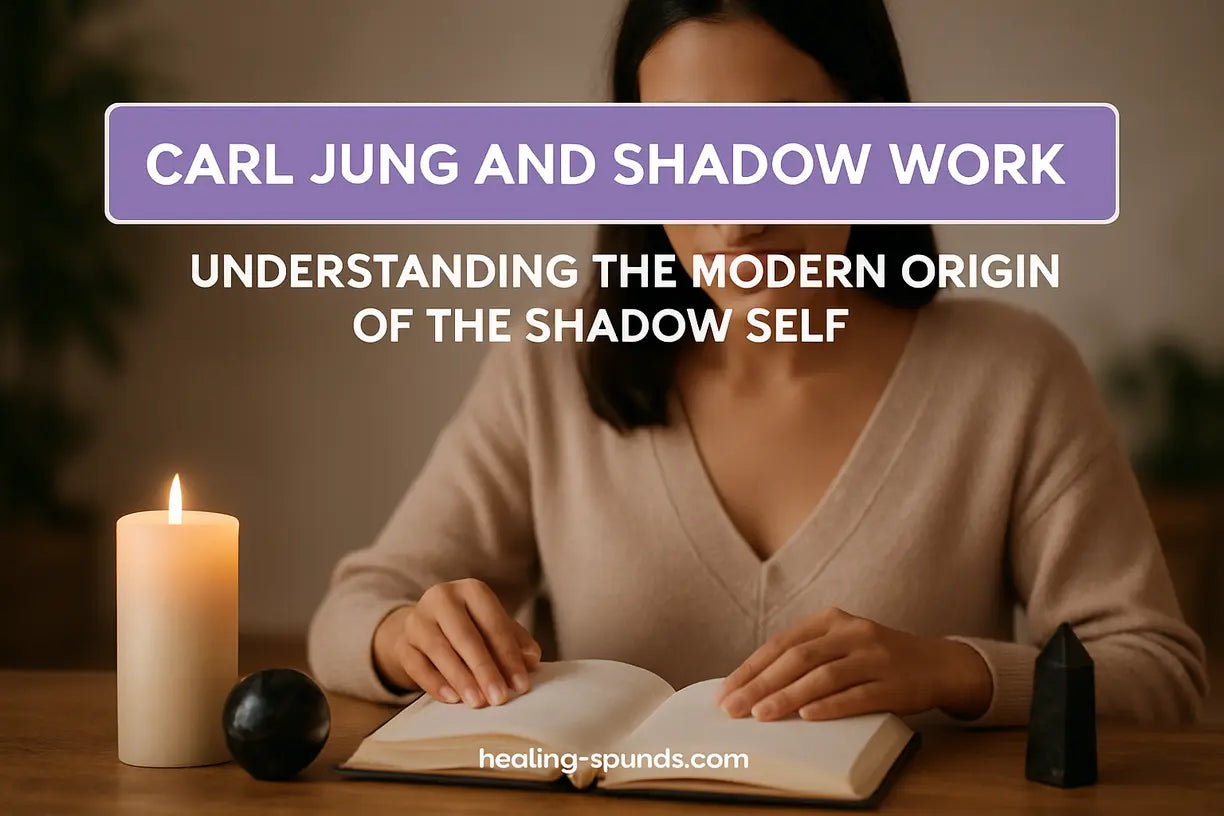Hatten Sie schon einmal das Gefühl, dass es einen Teil von Ihnen gibt, den Sie vor sich selbst verbergen? Eine Ansammlung von Impulsen, Wünschen und Emotionen, die Sie lieber nicht wahrnehmen möchten? Dieses verborgene Gebiet nannte der bahnbrechende Psychoanalytiker Carl Jung das „Schattenselbst“. Beim Verständnis der Prinzipien der Schattenarbeit, die Carl Jung entwickelte, geht es nicht darum, die Dunkelheit zu vertreiben, sondern darum, sich ganz und gar zu akzeptieren, um tiefgreifendes persönliches Wachstum zu ermöglichen. Diese Reise beginnt damit, zu verstehen, woher Ihr Schatten kommt.
Dieser Leitfaden beleuchtet die Ursprünge des Schattenselbst in der Jungschen Psychologie. Wir untersuchen, wie es entsteht, wie man seine Flüster- und Rufsignale im Alltag erkennt und warum seine Integration zu den wirksamsten Maßnahmen für das spirituelle und emotionale Wohlbefinden zählt.
Wer war Carl Jung und warum ist der Schatten wichtig?
Carl Jung war ein Schweizer Psychiater und Psychoanalytiker und Begründer der analytischen Psychologie. Im Gegensatz zu seinem Zeitgenossen Sigmund Freud legte er größeren Wert auf die spirituellen und kollektiven Aspekte der menschlichen Erfahrung. Im Mittelpunkt seines Werks steht das Konzept der Psyche, die seiner Ansicht nach aus dem Bewusstsein, dem persönlichen Unbewussten und dem kollektiven Unbewussten besteht. Der Schatten, ein zentraler Archetyp in Jungs Modell der Psyche , befindet sich im persönlichen Unbewussten .
Der Schatten ist der Speicher all dessen, was wir an uns selbst als inakzeptabel erachten. Er ist nicht grundsätzlich böse, sondern besteht vielmehr aus den Eigenschaften, Emotionen und Instinkten, die wir unterdrücken, um gesellschaftlichen Normen, familiären Erwartungen und unserem idealen Selbstbild zu entsprechen. Laut der Jungschen Schattenarbeit verschwindet dieser Teil unserer selbst nicht, wenn wir ihn ignorieren; er wird im Dunkeln nur stärker und beeinflusst unser Verhalten unbewusst.
Die Geburt des Schattens: Woher kommt er?
Die Entstehung des Schattens beginnt in der frühen Kindheit. Im Laufe unseres Lebens lernen wir, welche Verhaltensweisen und Gefühle „gut“ sind und uns Lob einbringen, und welche „schlecht“ sind und zu Bestrafung oder Missbilligung führen. Dieses Feedback von Eltern, Lehrern und der Gesellschaft im Allgemeinen lehrt uns, bestimmte Aspekte unserer Persönlichkeit zu unterdrücken.
Kindheit und soziale Konditionierung
Stellen Sie sich ein Kind vor, das von Natur aus ungestüm und durchsetzungsstark ist. Wenn man ihm wiederholt sagt, es solle „ruhig“ oder „brav“ sein, kann es sein Durchsetzungsvermögen in den Schatten stellen. Ebenso können Gefühle wie Wut, Traurigkeit oder Eifersucht als negativ abgestempelt werden, was dazu führt, dass wir sie innerlich verleugnen. Diese verleugneten Anteile verschwinden nicht; sie werden zur Grundlage unseres Schattenselbst . Dieser Prozess ist ein natürlicher Teil der Sozialisation, kann uns aber ohne bewusste Anstrengung später im Leben das Gefühl von Zerrissenheit und Unvollständigkeit hinterlassen.

Das persönliche Unbewusste als Behälter
In Jungs Theorie ist das persönliche Unbewusste der Speicherort all unserer vergessenen Erinnerungen, verdrängten Ideen und unterschwelligen Wahrnehmungen. Der Schatten ist ein wichtiger Bestandteil dieses Bereichs. Er enthält unentwickelte Talente, positive Eigenschaften, die wir zu verbergen gelernt haben (wie kreative Impulse oder gesunden Ehrgeiz), und die „primitiveren“ menschlichen Instinkte. Ziel der Schattenarbeit, die Jung vorschwebte, ist nicht die Zerstörung dieses Behälters, sondern das sorgfältige Auspacken seines Inhalts, um ihn zur Untersuchung und Integration ans Licht des Bewusstseins zu bringen.
So erkennen Sie Ihr eigenes Schattenselbst
Da der Schatten unbewusst wirkt, können Sie sich nicht einfach dazu entschließen, ihn direkt anzuschauen. Stattdessen müssen Sie lernen, seine Projektionen und Auswirkungen in Ihrem Alltag zu erkennen. Dies ist der erste entscheidende Schritt in der Praxis der Schattenarbeit.
Emotionale Projektionen und Auslöser
Eine der häufigsten Arten, wie sich der Schatten offenbart, sind starke emotionale Reaktionen auf andere Menschen. Wenn eine bestimmte Eigenschaft einer anderen Person – sei es Arroganz, Bedürftigkeit oder Faulheit – eine intensive, unverhältnismäßige Reaktion in Ihnen hervorruft, ist dies oft ein Zeichen dafür, dass Sie Ihren eigenen, unerkannten Schatten auf diese Person projizieren. Diese Person spiegelt lediglich einen Teil von Ihnen wider, den Sie verleugnet haben.
Wiederkehrende Muster und Selbstsabotage
Finden Sie sich immer wieder in denselben negativen Situationen wieder? Sabotieren Sie Ihren eigenen Erfolg oder Ihre Beziehungen, ohne zu verstehen, warum? Diese wiederkehrenden Muster werden oft von der Schattenseite gesteuert. Eine uneingestandene Angst vor Erfolg kann beispielsweise in Ihrem Schatten leben und dazu führen, dass Sie unbewusst Termine verpassen oder Konflikte verursachen, gerade wenn alles gut läuft. Das Erkennen dieser selbstzerstörerischen Zyklen ist der Schlüssel zum Verständnis dessen, was Ihre Schattenseite Ihnen sagen will.
Das Ziel der Jungschen Schattenarbeit: Integration, nicht Eliminierung
Ein weit verbreiteter Irrtum ist, dass es bei der Schattenarbeit darum geht, die „schlechten“ Seiten der eigenen Persönlichkeit loszuwerden. Jungs Philosophie ist das genaue Gegenteil. Das Ziel ist Integration – der Prozess, sich seiner Schattenseiten bewusst zu werden, sie zu akzeptieren und anzunehmen. Indem Sie diese verborgenen Aspekte in Ihr Bewusstsein bringen, gewinnen Sie die Energie zurück, die Sie für deren Unterdrückung aufgewendet haben.
Die Vorteile der Integration Ihres Schattens sind immens:
- Mehr Authentizität: Sie können ehrlicher und erfüllter als Ihr wahres Selbst leben.
- Gesteigerte Kreativität: Der Schatten birgt oft rohe, kraftvolle kreative Energie.
- Verbesserte Beziehungen: Indem Sie Ihre Projektionen zurückziehen, können Sie andere klarer sehen.
- Mehr Energie und Vitalität: Sie setzen die psychologische Energie frei, die Sie dafür verwenden, den Schatten verborgen zu halten.
Diese Reise erfordert Mut, Ehrlichkeit und die richtigen Werkzeuge, um Ihre Selbstbeobachtung zu unterstützen. Erdungsobjekte können unglaublich hilfreich sein, um einen sicheren Raum für diese tiefe innere Arbeit zu schaffen.
Obsidianturm für Klarheit und persönliche Ausrichtung
$39.99 $49.99
Erden Sie Ihre Schattenarbeit mit diesem Obsidianturm, perfekt für tiefe Selbstbeobachtung und die Konfrontation mit verborgenen Wahrheiten.
Produkt entdeckenPraktische Tools für Ihre Schattenarbeit
Schattenarbeit ist eine zutiefst persönliche Praxis. Es gibt viele Wege, aber einige grundlegende Werkzeuge können den Prozess der Entdeckung und Integration erleichtern. Die Schaffung eines sicheren, bewussten Raums ist für diese introspektive Arbeit von größter Bedeutung.

Eine der effektivsten Methoden ist das Führen eines Schattentagebuchs . Mithilfe von Impulsen, die Sie dazu anregen, Ihre Auslöser, Projektionen und Träume zu erforschen, können Sie eine direkte Verbindung zu Ihrem Unterbewusstsein herstellen. Studien bestätigen, dass ausdrucksstarkes Schreiben wie das Führen eines Tagebuchs dabei helfen kann, Ängste zu bewältigen und Stress abzubauen , wodurch ein klarerer Geisteszustand für die Selbstreflexion entsteht. Die Kombination dieser Praxis mit Meditation und Achtsamkeit hilft Ihnen, Ihre Gedanken ohne Vorurteile zu beobachten, wodurch Schattenseiten sanfter an die Oberfläche kommen.
[Sammlungs-Schieberegler]
Auch der Einsatz physischer Hilfsmittel kann Ihre Praxis vertiefen. Kristalle wie Obsidian sind für ihre erdenden Eigenschaften und ihre Fähigkeit bekannt, verborgene Wahrheiten an die Oberfläche zu bringen. Klangheilung mit Klangschalen kann das Nervensystem beruhigen und den Zugang zu tieferen Bewusstseinszuständen erleichtern, in denen Schatten lauern.

Verbessern Sie Ihre Praxis mit diesen Tools
$349.99
$419.99
Verstärken Sie die Meditation für die Jungsche Schattenarbeit mit dieser Obsidianklangschale, die auf Erdung und Integration abgestimmt ist. Mehr erfahren ➔
$39.99
$49.99
Verwenden Sie diese Obsidiankugel als Begleiter für die Schattenselbstreflexion und unterstützen Sie die Klarheit bei der inneren Arbeit. Mehr erfahren ➔
Fazit: Umarmen Sie Ihre Ganzheit
Die von Carl Jung beschriebene Reise der Schattenarbeit ist keine schnelle Lösung, sondern ein lebenslanger Weg der Selbstfindung. Sie beginnt mit dem Verständnis, dass Ihr Schattenselbst kein Feind ist, den es zu besiegen gilt, sondern ein verlorener Teil von Ihnen, der darauf wartet, wiederentdeckt zu werden. Indem Sie seine Ursprünge bis in Ihre frühesten Erfahrungen zurückverfolgen und lernen, seinen Einfluss auf Ihr Leben zu erkennen, machen Sie den ersten Schritt, Ihre Kraft zurückzugewinnen und ein integrierteres, authentischeres und ganzheitlicheres Individuum zu werden. Diese mutige Arbeit ist der Schlüssel zur Entfaltung Ihres vollen Potenzials.
Häufig gestellte Fragen zu Carl Jung und Schattenarbeit
In der Jungschen Theorie ist Schattenarbeit der Prozess der Erforschung des Unterbewusstseins, um das „Schattenselbst“ ins Bewusstsein zu bringen. Der Schatten besteht aus unterdrückten Ideen, Schwächen, Wünschen, Instinkten und Unzulänglichkeiten, die das Bewusstsein nicht wahrnehmen will. Ziel ist es, diese verborgenen Aspekte zu integrieren , um einen Zustand der Ganzheit und Selbsterkenntnis zu erreichen, anstatt zuzulassen, dass sie unbewusst das eigene Verhalten steuern.
Carl Jungs Schattenmodell beschreibt den Schatten als grundlegenden Archetyp der menschlichen Psyche, der im persönlichen Unterbewusstsein angesiedelt ist. Er ist die „dunkle Seite“ unserer Persönlichkeit und umfasst alle Teile von uns, die wir aufgrund sozialer Konditionierung und persönlicher Ideale unterdrückt oder abgelehnt haben. Jung glaubte, der Schatten sei nicht von Natur aus böse, sondern berge ungenutztes Potenzial und Energie . Ihn anzuerkennen und zu integrieren sei für persönliches Wachstum unerlässlich, ein Prozess, den er „Individuation“ nannte.
Sie können Ihren Jungschen Schatten erkennen, indem Sie auf mehrere wichtige Anzeichen achten. Dazu gehören: starke, irrationale emotionale Reaktionen auf Eigenschaften anderer Menschen (Projektion), wiederkehrende negative Muster in Ihrem Leben, selbstzerstörerisches Verhalten und die Analyse des symbolischen Inhalts Ihrer Träume. Ehrliche Selbstreflexion, oft durch Tagebuchschreiben oder Therapie, ist entscheidend, um diese Hinweise zu erkennen.
Obwohl Jung ausführlich zu diesem Thema geschrieben hat, gibt es kein direktes „How-to“-Buch von ihm. Zum Verständnis des Konzepts sind Teile von „Die Archetypen und das kollektive Unbewusste“ unerlässlich. Für einen leichteren und praktischeren Zugang beginnen viele Leser jedoch mit Büchern moderner Jungscher Analytiker. Ein sehr empfehlenswertes Buch ist „Owning Your Own Shadow: Understanding the Dark Side of the Psyche“ von Robert A. Johnson, das Jungs Konzepte in verständliche Begriffe für die persönliche Anwendung zerlegt.
Schattenarbeit ist nicht grundsätzlich gefährlich, kann aber emotional herausfordernd sein. Sie beinhaltet die Konfrontation mit unangenehmen Wahrheiten und schmerzhaften Erinnerungen. Es ist wichtig, mit Selbstmitgefühl, Geduld und starker emotionaler Unterstützung an die Arbeit zu gehen. Wenn Sie in der Vergangenheit schwere Traumata erlitten haben, wird dringend empfohlen, die Schattenarbeit unter Anleitung eines qualifizierten Therapeuten oder Jungianischen Analytikers durchzuführen, um einen sicheren und konstruktiven Prozess zu gewährleisten.







